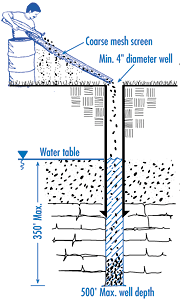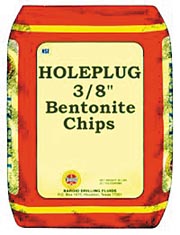
Chipped bentonite products commonly are used to fill wells and drillholes. The chips may be used for both sand and gravel formation wells and bedrock wells. They may be used for wells and drillholes meeting the following specifications:
- 4 inches or larger in diameter
- not more than 500 feet deep
- not more than 350 feet of water standing in the well or drillhole
Chipped bentonite should not be used to fill wells or drillholes filled with drilling mud or clay slurry and should not be used for small diameter driven point wells.
Chipped bentonite also can be used to fill dug wells, or as an alternative to concrete in the top 5 feet when clay slurry is used to fill a well or drillhole from the bottom up to the 5-foot depth.
Bentonite chips come in two basic size ranges - 1/4 to 3/8-inch, and 1/2- to 3/4-inch chips. The 1/4- to 3/8-inch chips should be used for 4-inch diameter wells. Bentonite chips are irregularly shaped pieces of sodium bentonite clay that look very much like crushed limestone. They should not be confused with pellets or tablets, which are not allowed.

1) Determine the construction details of the well or drillhole. At minimum, you need to determine the well's or drillhole's diameter and depth.
2) Remove the pump, pump piping, and any other material obstructions or debris in the well or drillhole that could prevent complete filling.
3) Calculate the volume of the well or drillhole to determine the number of bags of chips that will be required.
4) Fine particles and dust contained in the bags of bentonite chips must not be allowed to enter the well. This is prevented by pouring the bentonite chips out of the bag such that they tumble under their own weight down across a coarse-mesh screen 2 feet to 3 feet in length. This allows the dust to fall through the screen onto the ground. The screen should be formed into a U-shape like a rain gutter. One end of the screen should be placed on the top of the well casing while the other end is supported at a steep angle. Removal of the dust prevents bridging of the chips at the water table. Do not push or pull the chips down across the screen as this will only create more dust.
5) Pour the bentonite chips across the screen into the top of the well at a rate not faster than three minutes per bag. Pour at this rate so bridging of the chips does not occur - the chips must fall all the way to the bottom of the well. (Do not use a conductor-tremie pipe.) Check periodically with a weighted line for possible bridging of chips.
6) Make sure the well takes in the entire number of bags calculated to fill it. If it doesn't, bridging may have occurred. The point of bridging must be broken so the bentonite chips will fall to the bottom. If the bridge cannot be broken, the well may have to be drilled out and refilled with neat cement grout.
7) If the standing water in the well does not rise to the surface during the filling procedure, clean, uncontaminated water must be poured down into the well (through the chips) until water rises up to the top of the well and stays there. The chips will then swell and create an impermeable plug in the well.

Materials and Methods
Some material definitions:Clean clay or silt or clean native soil - low permeability soil material, free of organic humus or any other contamination.
Neat cement grout - a mixture of cement and water in the proportion of one bag of Portland cement (94 pounds) meeting ASTM C 150, Type I or API-10A, Class A standard; and 5 gallons to 5.5 gallons of water from a known safe and uncontaminated source. Powdered bentonite may be added - up to 5 pounds per 94-pound bag of cement, provided 1.3 gallons of water is added for each 2 pounds of bentonite added.
Concrete - a mixture of cement, water, sand and gravel in the proportion of one bag of Portland cement, an equal measure of gravel (bt weight or volume) and not more than 5.5 gallons of water from a known safe and uncontaminated source. A commercially prepared mix may be used provided the mix has at least six bags of cement per cubic yard.
Sand cement grout - a mixture of cement, sand and water in the proportion of one bag of Portland cement, a cubic foot of dry sand and 5 gallons to 5.5 gallons of clean water from a known safe and uncontaminated source.
Clay- or bentonite-sand slurry - a mixture having the minimum ratio of 50 pounds of native clay or approved bentonite mixed with 100 gallons of water (from a known safe and uncontaminated source) and 10 percent to 25 percent sand by volume of the slurry such that a mud weight of at least 11 pounds per gallon is achieved.
1. Bentonite chips may only be used for wells not deeper than 500 feet and having not more than 350 feet of standing water in them. The chips must be poured across a coarse mesh screen such that excess dust does not enter the well. Pour rate should not be faster than 3 minutes per 50-pound bag to prevent bridging.
2. Neat cement grout and sand-cement grout must have a density of at least 15.2 pounds per gallon.
3. When concrete is used, the gravel size may not exceed 1/3 the inside diameter of the conductor pipe used.
4. Driven-point (sand-point) wells may be pulled prior to filling the hole if the well is 25 feet deep or less.
5. The terms conductor pipe and tremie pipe are synonymous. The bottom of the pipe must remain submerged in the grout throughout the filling procedure. Conductor pipe must be metal pipe, thermoplastic pipe rated for at least 100 psi, or rubber-covered hose reinforced with braided fiber or steel, and rated for at least 300 psi.
6. Forty-foot impermeable plugs shall be provided at each bedrock
formation change.
7. The top 5 feet of dug well curbing must be knocked out to provide a soil contact with the filling material.
Tremie Pipe
Conductor (tremie) pipe used for well abandonment shall be any of the following:
1. Metal pipe
2. Rubber-covered hose reinforced with braided fiber or steel, and rated for at least 300 psi
3. Thermoplastic pipe rated for at least 100 psi including:
a. polyvinyl chloride (PVC),
b. chlorinated polyvinyl chloride (CPVC),
c. polyethylene (PE),
d. polybutylene (PB) and
e. acrylonitrile butadiene styrene (ABS)




Report Abusive Comment